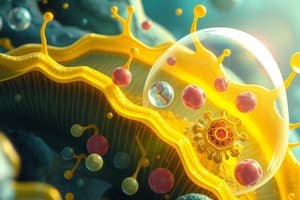Podcast
Questions and Answers
The ______ is the control center of the cell, containing the cell's genetic material, or DNA.
The ______ is the control center of the cell, containing the cell's genetic material, or DNA.
nucleus
The cell membrane, also known as the ______, is a selectively permeable barrier that separates the interior of the cell from the extracellular environment.
The cell membrane, also known as the ______, is a selectively permeable barrier that separates the interior of the cell from the extracellular environment.
plasma membrane
The nucleus is responsible for coordinating various cellular activities, such as cell growth, division, and ______.
The nucleus is responsible for coordinating various cellular activities, such as cell growth, division, and ______.
death
The cell membrane is composed of a lipid bilayer and ______, and its main function is to regulate the movement of substances in and out of the cell.
The cell membrane is composed of a lipid bilayer and ______, and its main function is to regulate the movement of substances in and out of the cell.
The ______ is enclosed by a double-layered membrane and has several sub-regions, such as the nucleolus, which plays a key role in protein synthesis.
The ______ is enclosed by a double-layered membrane and has several sub-regions, such as the nucleolus, which plays a key role in protein synthesis.
Active transport is a process in which substances are transported across a membrane against their concentration gradient, requiring the input of energy in the form of ______.
Active transport is a process in which substances are transported across a membrane against their concentration gradient, requiring the input of energy in the form of ______.
The endoplasmic reticulum (ER) is involved in various cellular processes, such as protein synthesis, lipid synthesis, and ______.
The endoplasmic reticulum (ER) is involved in various cellular processes, such as protein synthesis, lipid synthesis, and ______.
Mitochondria are organelles that generate the energy-rich molecule ATP through a process called cellular ______.
Mitochondria are organelles that generate the energy-rich molecule ATP through a process called cellular ______.
Passive membrane transport refers to the movement of substances across a membrane without the input of ______.
Passive membrane transport refers to the movement of substances across a membrane without the input of ______.
The nucleus serves as the control center of the cell, while the cell membrane regulates the movement of substances in and out of the ______.
The nucleus serves as the control center of the cell, while the cell membrane regulates the movement of substances in and out of the ______.
Flashcards are hidden until you start studying
Study Notes
Biology - Cell Organelles and Membrane Transport
Introduction
Cell organelles and membrane transport are crucial aspects of cell biology, as they play a significant role in maintaining the structure and function of cells. In this article, we will explore the key cell organelles and the various types of membrane transport, including active transport, endoplasmic reticulum, mitochondria, and passive membrane transport.
Cell Organelles
Nucleus
The nucleus is the control center of the cell, containing the cell's genetic material, or DNA. It is enclosed by a double-layered membrane and has several sub-regions, such as the nucleolus, which plays a key role in protein synthesis. The nucleus is responsible for coordinating various cellular activities, such as cell growth, division, and death.
Cell Membrane
The cell membrane, also known as the plasma membrane, is a selectively permeable barrier that separates the interior of the cell from the extracellular environment. It is composed of a lipid bilayer and proteins, and its main function is to regulate the movement of substances in and out of the cell. The cell membrane is continuously active, allowing for the exchange of materials and ions between the cell and its surroundings while maintaining the cell's internal environment.
Membrane Transport
Active Transport
Active transport is a process in which substances are transported across a membrane against their concentration gradient, requiring the input of energy in the form of ATP. This process is essential for maintaining the balance of electrolytes and other substances within the cell, and it is carried out by specific transport proteins embedded in the cell membrane.
Endoplasmic Reticulum
The endoplasmic reticulum (ER) is a network of tubes and membranes within the cytoplasm of a cell, continuous with the outer membrane of the nuclear envelope. It is involved in various cellular processes, such as protein synthesis, lipid synthesis, and detoxification. The ER also plays a key role in the secretory pathway, transporting proteins and lipids from the Golgi apparatus to their final destinations.
Mitochondria
Mitochondria are organelles that generate the energy-rich molecule ATP through a process called cellular respiration. They are known as the "powerhouse" of the cell, as they produce most of the cell's ATP through a series of redox reactions. Mitochondria have their own DNA, separate from the cell's nucleus, and they play a crucial role in cellular metabolism and energy production.
Passive Membrane Transport
Passive membrane transport refers to the movement of substances across a membrane without the input of energy. This process occurs naturally, driven by concentration gradients, and it is responsible for the diffusion of substances such as oxygen, carbon dioxide, and water across cell membranes.
Conclusion
In summary, cell organelles and membrane transport are essential for maintaining the structure and function of cells. The nucleus serves as the control center of the cell, while the cell membrane regulates the movement of substances in and out of the cell. Active transport, endoplasmic reticulum, mitochondria, and passive membrane transport are all crucial processes that contribute to the overall functioning of the cell. Understanding these processes is key to understanding the complex mechanisms that govern cell biology.
Studying That Suits You
Use AI to generate personalized quizzes and flashcards to suit your learning preferences.




